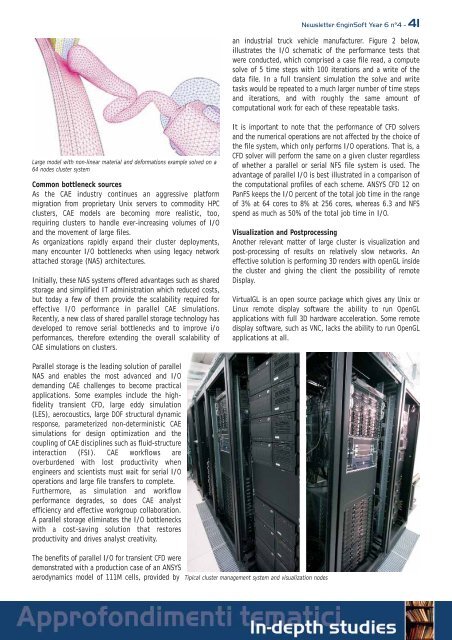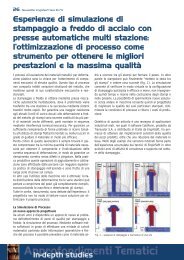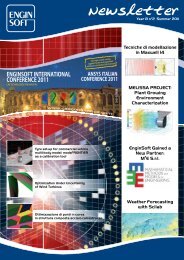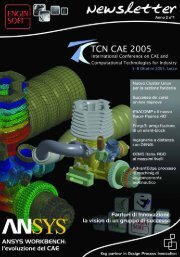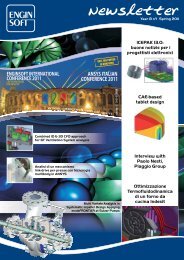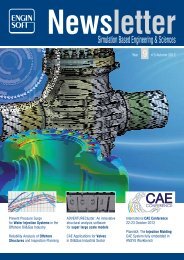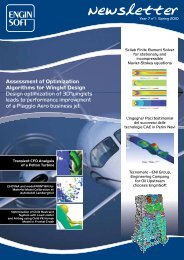software training courses 2010 corsi di addestramento ... - EnginSoft
software training courses 2010 corsi di addestramento ... - EnginSoft
software training courses 2010 corsi di addestramento ... - EnginSoft
Create successful ePaper yourself
Turn your PDF publications into a flip-book with our unique Google optimized e-Paper software.
Large model with non-linear material and deformations example solved on a<br />
64 nodes cluster system<br />
Common bottleneck sources<br />
As the CAE industry continues an aggressive platform<br />
migration from proprietary Unix servers to commo<strong>di</strong>ty HPC<br />
clusters, CAE models are becoming more realistic, too,<br />
requiring clusters to handle ever-increasing volumes of I/O<br />
and the movement of large files.<br />
As organizations rapidly expand their cluster deployments,<br />
many encounter I/O bottlenecks when using legacy network<br />
attached storage (NAS) architectures.<br />
Initially, these NAS systems offered advantages such as shared<br />
storage and simplified IT administration which reduced costs,<br />
but today a few of them provide the scalability required for<br />
effective I/O performance in parallel CAE simulations.<br />
Recently, a new class of shared parallel storage technology has<br />
developed to remove serial bottlenecks and to improve i/o<br />
performances, therefore exten<strong>di</strong>ng the overall scalability of<br />
CAE simulations on clusters.<br />
Parallel storage is the lea<strong>di</strong>ng solution of parallel<br />
NAS and enables the most advanced and I/O<br />
deman<strong>di</strong>ng CAE challenges to become practical<br />
applications. Some examples include the highfidelity<br />
transient CFD, large eddy simulation<br />
(LES), aerocoustics, large DOF structural dynamic<br />
response, parameterized non-deterministic CAE<br />
simulations for design optimization and the<br />
coupling of CAE <strong>di</strong>sciplines such as fluid-structure<br />
interaction (FSI). CAE workflows are<br />
overburdened with lost productivity when<br />
engineers and scientists must wait for serial I/O<br />
operations and large file transfers to complete.<br />
Furthermore, as simulation and workflow<br />
performance degrades, so does CAE analyst<br />
efficiency and effective workgroup collaboration.<br />
A parallel storage eliminates the I/O bottlenecks<br />
with a cost-saving solution that restores<br />
productivity and drives analyst creativity.<br />
The benefits of parallel I/O for transient CFD were<br />
demonstrated with a production case of an ANSYS<br />
aerodynamics model of 111M cells, provided by<br />
Newsletter <strong>EnginSoft</strong> Year 6 n°4 - 41<br />
an industrial truck vehicle manufacturer. Figure 2 below,<br />
illustrates the I/O schematic of the performance tests that<br />
were conducted, which comprised a case file read, a compute<br />
solve of 5 time steps with 100 iterations and a write of the<br />
data file. In a full transient simulation the solve and write<br />
tasks would be repeated to a much larger number of time steps<br />
and iterations, and with roughly the same amount of<br />
computational work for each of these repeatable tasks.<br />
It is important to note that the performance of CFD solvers<br />
and the numerical operations are not affected by the choice of<br />
the file system, which only performs I/O operations. That is, a<br />
CFD solver will perform the same on a given cluster regardless<br />
of whether a parallel or serial NFS file system is used. The<br />
advantage of parallel I/O is best illustrated in a comparison of<br />
the computational profiles of each scheme. ANSYS CFD 12 on<br />
PanFS keeps the I/O percent of the total job time in the range<br />
of 3% at 64 cores to 8% at 256 cores, whereas 6.3 and NFS<br />
spend as much as 50% of the total job time in I/O.<br />
Visualization and Postprocessing<br />
Another relevant matter of large cluster is visualization and<br />
post-processing of results on relatively slow networks. An<br />
effective solution is performing 3D renders with openGL inside<br />
the cluster and giving the client the possibility of remote<br />
Display.<br />
VirtualGL is an open source package which gives any Unix or<br />
Linux remote <strong>di</strong>splay <strong>software</strong> the ability to run OpenGL<br />
applications with full 3D hardware acceleration. Some remote<br />
<strong>di</strong>splay <strong>software</strong>, such as VNC, lacks the ability to run OpenGL<br />
applications at all.<br />
Tipical cluster management system and visualization nodes


